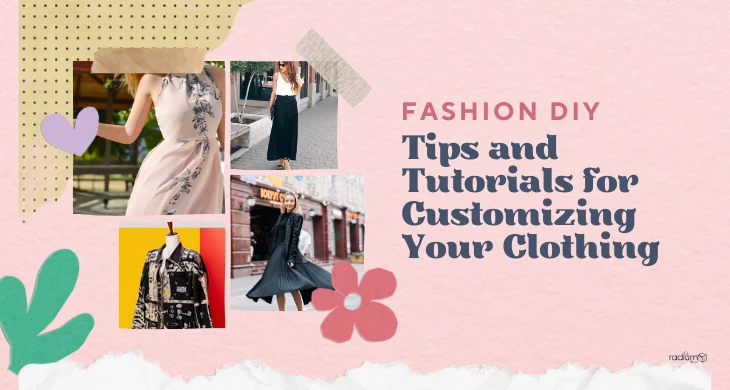In a world of fast fashion, where trends come and go, it’s easy to feel like your wardrobe lacks uniqueness. But fear not! With a little creativity and some simple tools, you can transform your clothing into personalized pieces that reflect your style and personality. In this blog, we’ll explore the exciting world of fashion do-it-yourself (DIY), providing you with tips, tutorials, and inspiration to customize your clothing.
This is where Fashion DIY (Do-It-Yourself) comes to the rescue. It’s a world where your creativity knows no bounds, where you become the designer, the artist, and the curator of your own style. Fashion DIY is the art of taking your existing clothing pieces and transforming them into something entirely new and uniquely yours.
In this blog, we’ll dive deep into the fascinating realm of Fashion DIY. We’ll explore essential tools and materials, basic customization techniques, advanced projects, sustainable practices, and even how to showcase your creations. Whether you’re a seasoned DIY enthusiast or a complete beginner, this series will provide you with the inspiration, knowledge, and step-by-step tutorials you need to embark on your own creative journey.
Essential Tools and Materials for Fashion DIY:
To embark on your exciting journey into Fashion DIY, it’s crucial to have the right tools and materials at your disposal. These essentials will serve as the building blocks for your creative projects, allowing you to transform ordinary clothing into personalized works of art. Let’s dive into the must-have items:
1. Sewing Machine: A reliable sewing machine is a game-changer for any DIY enthusiast. It enables you to stitch, hem, and customize garments with precision and speed. Invest in a machine that suits your skill level, from basic models to advanced ones with various features.
2. Hand Sewing Kit: Even if you have a sewing machine, a hand sewing kit is indispensable for delicate tasks and repairs. Ensure it includes needles, threads in various colors, pins, scissors, and a thimble.
3. Fabric Paints and Brushes: Fabric paints open up a world of possibilities for customizing clothing. Choose high-quality fabric paints in a range of colors and complement them with fine brushes for detailed work.
4. Embellishments: Beads, sequins, patches, and appliques are fantastic for adding texture and character to your clothing. They come in various shapes, sizes, and designs, allowing you to personalize your pieces in unique ways.
5. Cutting Tools: A good set of fabric scissors and a rotary cutter with a cutting mat are essential for precision cutting and trimming. Invest in quality tools to make your DIY projects easier.
6. Iron and Ironing Board: A reliable iron and ironing board are crucial for pressing seams, applying heat-transfer designs, and ensuring your DIY creations look polished and professional.
7. Fabric Glue and Adhesives: Fabric glue and adhesives are handy for quick fixes, attaching embellishments, or securing hems without sewing. Look for washable and durable options.
8. Measuring Tools: A flexible measuring tape, ruler, and tailor’s chalk will help you take accurate measurements and mark fabric for cutting and sewing.
9. Patterns and Templates: Depending on your projects, you may need patterns or templates for various garment styles or design elements.
10. Safety Gear: Don’t forget safety gear like safety pins, gloves, and protective eyewear, especially when working with sharp tools or chemicals.
Basic Clothing Customization Techniques:
Now that you have your essential tools and materials ready, it’s time to delve into basic clothing customization techniques. These foundational skills will empower you to transform your garments, adding personal flair and uniqueness to your wardrobe. Let’s explore some essential techniques:
1. Adding Embellishments: Embellishments like beads, sequins, and patches can breathe new life into plain clothing. Use fabric glue or sewing techniques to attach these embellishments in patterns, designs, or random arrangements to create eye-catching details.
2. Fabric Painting and Printing: Fabric paints and brushes allow you to become an artist on clothing canvas. Experiment with stencils, freehand designs, or even block printing to add color and patterns to your garments.
3. Basic Sewing and Stitching: Mastering basic sewing stitches is essential for clothing customization. Start with straight stitches, backstitches, and running stitches to secure hems, attach patches, or make minor alterations. Practice on scrap fabric before working on your clothing.
4. Hemming and Alterations: Learning how to hem pants, skirts, or dresses can make a big difference in the fit and style of your clothing. Whether you’re shortening a hemline or taking in a seam for a better fit, these skills are valuable for tailoring your wardrobe.
5. Dyeing Fabric: Fabric dyeing allows you to change the color of your clothing or refresh faded garments. Follow dye instructions carefully, and consider tie-dye or dip-dye techniques for creative effects.
Upcycling and Repurposing:
In a world increasingly focused on sustainability, upcycling and repurposing have emerged as powerful tools for transforming your wardrobe. These techniques not only reduce fashion waste but also allow you to create unique and eco-friendly fashion statements. Here’s how to upcycle and repurpose your clothing:
1. Upcycling Basics: Upcycling involves taking old or unused clothing items and giving them a fresh purpose or style. For example, you can turn a worn-out pair of jeans into stylish shorts or transform a dated dress into a trendy top. The possibilities are endless.
2. Assess Your Wardrobe: Start by taking a close look at your wardrobe. Identify clothing pieces that you no longer wear or those that could benefit from a new lease on life. Consider factors like fabric quality, fit, and potential for customization.
3. Get Creative with Cutting: Cutting and altering garments are key aspects of upcycling. You can crop t-shirts, create distressed denim, or even make patchwork designs by combining different fabrics. Invest in a good pair of fabric scissors and a cutting mat for precision.
4. Sewing and Stitching: Basic sewing skills are invaluable for upcycling. Learn to sew hems, attach patches, or take in seams to achieve the desired fit and style. If you’re new to sewing, start with simple projects and gradually work your way up to more complex ones.
5. Mix and Match: Don’t hesitate to mix and match fabrics, colors, and textures. Combine elements from different clothing pieces to create a truly unique item. For example, you can sew lace panels onto a plain blouse or add leather patches to jeans.
6. Accessorize: Accessories can enhance your upcycled creations. Add buttons, beads, ribbons, or embroidery to personalize your designs further. These small details can make a big difference.
Personalizing Your Wardrobe:
Your wardrobe is more than just a collection of clothing; it’s a reflection of your unique style and personality. Personalizing your wardrobe allows you to turn ordinary garments into extraordinary statements of self-expression. Here’s how to add a personal touch to your clothing:
1. Monogramming and Initials: Monogramming your clothing is a classic way to make your mark. Add your initials or a meaningful symbol to shirts, jackets, or accessories. You can either embroider them yourself or seek professional monogramming services.
2. Customized T-Shirts and Hoodies: Transform plain t-shirts and hoodies into personalized fashion statements. Consider screen printing your favorite quotes, artwork, or custom designs onto these casual staples. Online printing services make this process easy and accessible.
3. Fabric Applique: Fabric applique involves attaching fabric shapes or designs to your clothing. Create your own applique designs or use pre-made motifs. This technique allows you to add playful or artistic elements to your outfits.
4. Painted Denim: Give your denim a unique twist by painting it with fabric paints. Create abstract designs, intricate patterns, or even scenic landscapes on your jeans or denim jackets. Let your creativity run wild.
5. Hand-Embroidery: Hand-embroidery is a delicate and artistic way to personalize clothing. Stitch your favorite quotes, flowers, or symbols onto pockets, collars, or cuffs. Embroidery floss comes in a wide range of colors, allowing you to add vibrant accents to your garments.
Sustainable Fashion DIY:
As sustainability becomes an integral part of the fashion industry, embracing sustainable fashion DIY practices is not only trendy but also essential for minimizing environmental impact. By upcycling, repurposing, and making eco-conscious choices, you can contribute to a more sustainable wardrobe. Here’s how to practice sustainable fashion DIY:
1. Upcycling Old Garments:
- Revive and Renew: Give new life to old clothing by upcycling. Turn worn-out jeans into shorts, transform oversized shirts into trendy crop tops, or repurpose dresses into skirts. Upcycling reduces waste and conserves resources.
- Mix and Match Fabrics: Combine various fabric scraps to create patchwork designs or unique accessories. Mixing fabrics not only adds character but also reduces the need for new material production.
2. Sustainable Fabric Choices:
- Eco-Friendly Materials: Opt for sustainable fabrics like organic cotton, hemp, Tencel, or recycled polyester when starting DIY projects.
- Thrift Store Finds: Thrift shops and vintage stores offer a treasure trove of secondhand clothing options. Choose pre-loved garments for your projects, diverting them from landfills and supporting a circular fashion economy.
3. Natural Dyeing Techniques:
- Plant-Based Dyes: Experiment with natural dyes extracted from plants, fruits, or even kitchen ingredients like turmeric or avocado pits. Natural dyeing reduces the use of chemical dyes and minimizes water pollution.
- Low-Impact Dyeing: If using synthetic dyes, select low-impact, eco-friendly dye brands that prioritize sustainability and adhere to responsible dyeing practices.
4. Minimal Waste Practices:
- Zero-Waste Patterns: Explore zero-waste sewing patterns designed to maximize fabric usage and minimize scraps. These patterns create little to no waste during the cutting process.
- Use Scrap Fabric Creatively: Keep fabric scraps for future projects. Create accessories, patchwork designs, or small textile crafts from leftover pieces.
5. Repair and Maintain:
- Mend and Patch: Extend the lifespan of your clothing by repairing minor damages, like loose seams or small holes. Add decorative patches to cover imperfections and give garments a new look.
- Proper Care: Follow care instructions to ensure your DIY creations last longer. Wash clothes using eco-friendly detergents and cold water, and avoid excessive heat from dryers.
6. Eco-Friendly Fasteners:
- Sustainable Buttons: Choose buttons made from natural materials like wood, coconut shells, or recycled materials for a sustainable finishing touch on your garments.
- Snaps and Zippers: Consider using reclaimed or recycled snaps and zippers from old clothing or accessories.
DIY Fashion Trends:
Fashion trends come and go, but one trend that’s always in style is DIY fashion. Embracing DIY fashion allows you to customize your wardrobe, keep up with the latest styles, and express your individuality. Here are some DIY fashion trends to inspire your creativity:
1. Tie-Dye Revival:
- Tie-Dye Everything: Tie-dye is back and bolder than ever. Experiment with tie-dye techniques on t-shirts, sweatshirts, dresses, and even socks. Create psychedelic swirls, vibrant rainbows, or subtle pastel patterns.
- Reverse Tie-Dye: Flip the script by trying reverse tie-dye with bleach on dark-colored clothing for a unique twist on this trend.
2. Embroidery Extravaganza:
- Embroidered Denim: Elevate your denim game with intricate embroidery. Stitch flowers, animals, or custom designs onto jeans, jackets, or even denim skirts.
- Personalized Patches: Design and sew your own embroidered patches to add character to your jackets, backpacks, or hats.
3. Vintage Vibes:
- Thrifting and Upcycling: Embrace the vintage look by thrifting old pieces and giving them new life. Turn vintage dresses into modern fashion statements or rock retro-inspired outfits.
- Reworked Vintage: Combine elements from different vintage clothing items to create entirely new pieces. Mix and match fabrics, collars, and patterns to achieve a fresh vintage-inspired look.
4. Painted Perfection:
- Hand-Painted Designs: Unleash your inner artist with hand-painted clothing. Create custom artwork on t-shirts, canvas shoes, or even denim jackets. Express your unique style through paint and brushes.
- Abstract Expressionism: Experiment with abstract designs, splatters, or graffiti-style art for an edgy and artistic vibe.
5. Sustainable Streetwear:
- Eco-Friendly Fashion: Dive into sustainable DIY by upcycling old clothing into trendy streetwear pieces. Crop oversized hoodies, add patches, or repurpose worn-out jeans.
- Vintage Street Style: Combine vintage finds with modern streetwear essentials for a one-of-a-kind urban look.
6. Patchwork Passion:
- Crafting Patchwork Styles: Craft unique designs on garments by blending various fabrics, textures, and hues.This trend allows you to embrace a unique and eclectic style.
- Quilting Inspiration: Draw inspiration from quilting techniques to craft stunning patchwork coats, jackets, or skirts.
FAQS:
Ques: What are some essential tools for DIY fashion?
Ans :Essential tools include a sewing machine, fabric scissors, pins, measuring tape, a variety of needles, and an iron. Additionally, keep a well-stocked sewing kit with thread, buttons, and zippers.
Ques: How do I choose the right fabric for my DIY project?
Ans: Consider the project’s purpose and the fabric’s weight, drape, and stretch. For beginners, opt for fabrics like cotton or jersey, which are easy to work with.
Ques: I’m having trouble sewing straight lines. Any tips?
Ans: Practice sewing straight lines on scrap fabric before working on your project. Use the sewing machine’s guidelines or draw lines with removable fabric markers as a visual guide.
Ques: What’s the best way to fix a sewing mistake?
Ans:For minor mistakes, you can use a seam ripper to carefully remove stitches and redo them. For larger errors, consider incorporating the mistake into the design or using patches or embellishments to cover it.
Conclusion:
Get ready to embark on a journey of self-expression and style as we dive into the world of DIY fashion. Whether you’re a seasoned DIY enthusiast or just starting, this blog will inspire you to revamp your wardrobe and turn your clothing into one-of-a-kind fashion statements. Get your creative juices flowing, and let’s get started on your personalized fashion adventure!




